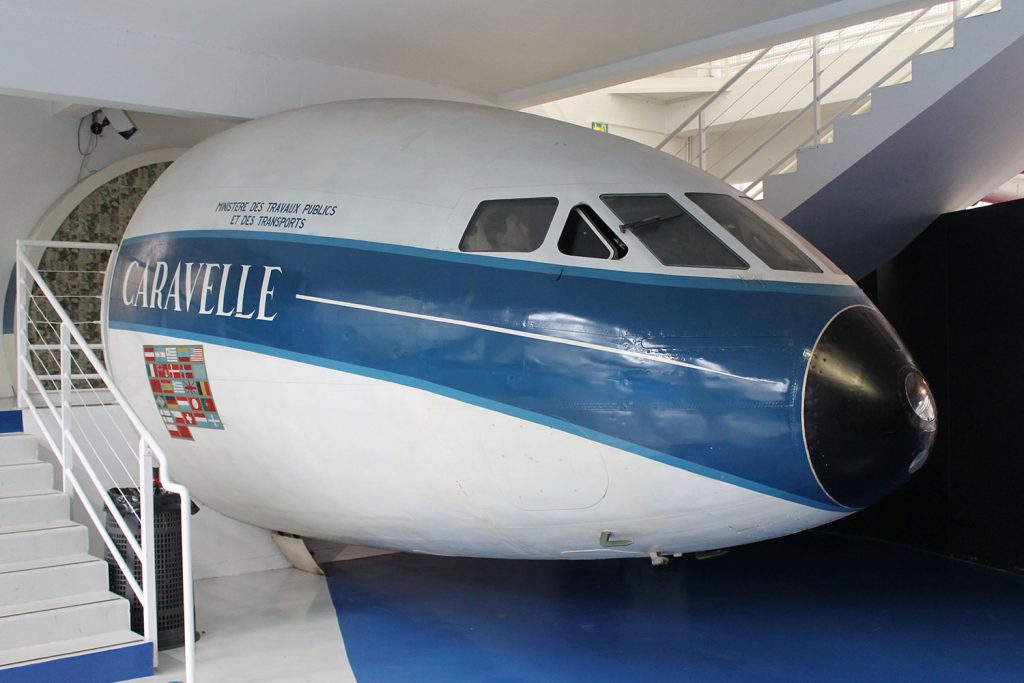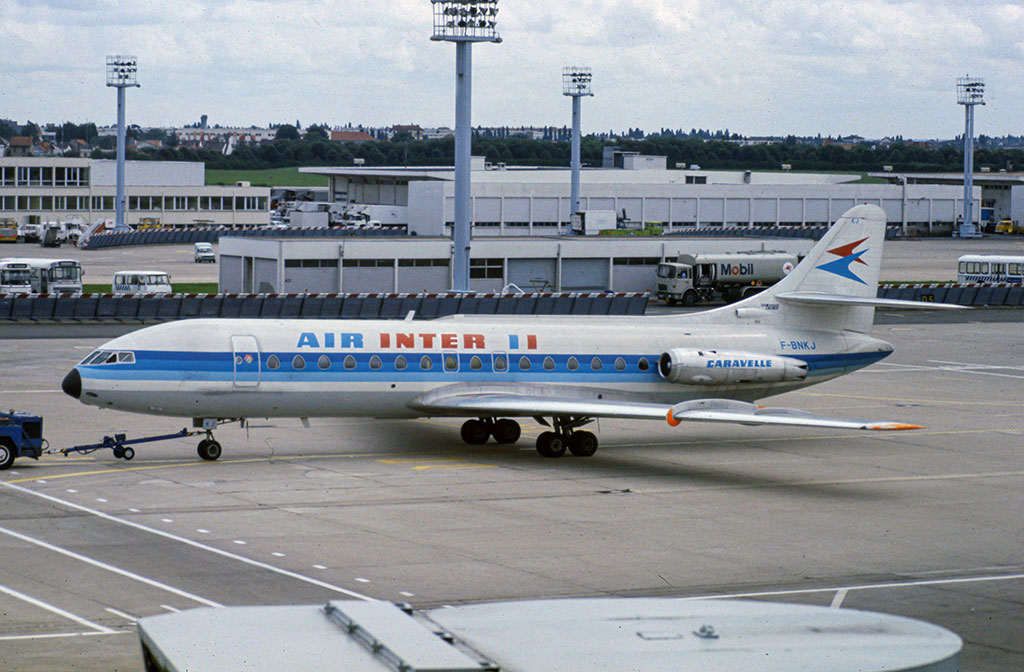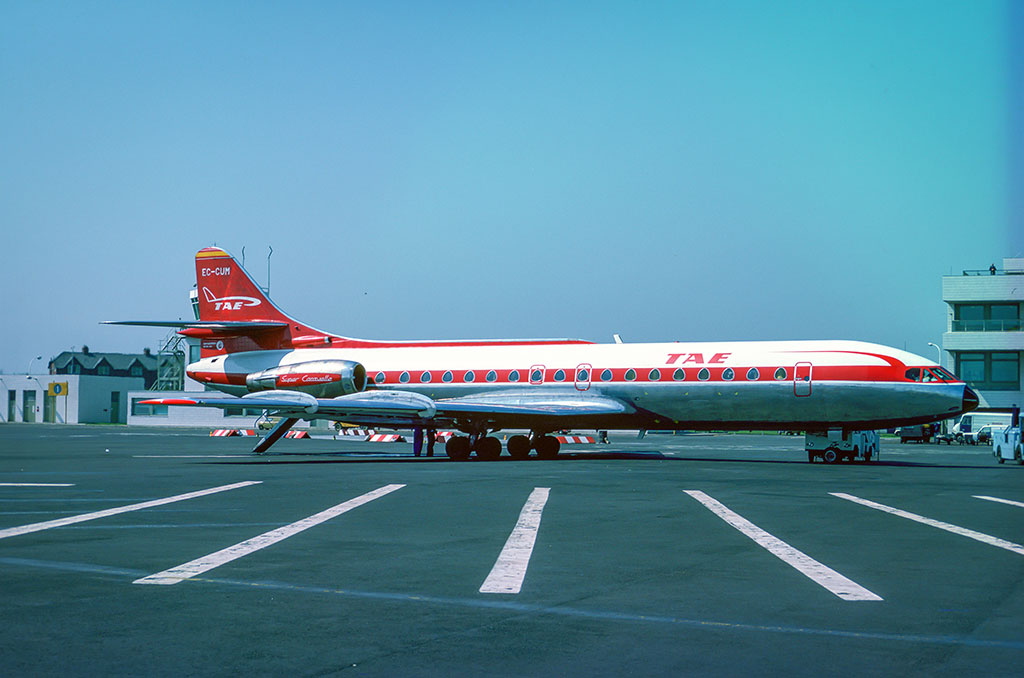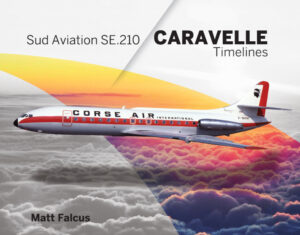Summary
One of the world’s first jet airliners, the Sud Aviation Caravelle was developed in France in the 1950s and carried on in production until the 1970s.
During that time the aircraft was updated and upgraded with new engines, avionics and fuselage stretches to offer customers different options.
So, what were the different types of Caravelle jet? Here’s a summary.
Caravelle I

Caravelle I prototype F-BHHI at Le Bourget, France
The initial model was the Caravelle I, comprising the prototypes and early deliveries to Air France, Air Algerie, SAS and VARIG. These were powered by Rolls-Royce RA-26 Avon Mk 522 engines.
This initial variant was the base model for future Caravelles and included capacity for up to 80 passengers.
Caravelle IA
An upgrade to the Avon engines was developed by Rolls-Royce whereby thrust was increased and noise levels reduced, as well as offering strengthened casing and improved cooling. This was the Avon Mk 522A. Aircraft with this engine were designated Caravelle IA, and entered service in February 1960 with Finnair, who had ordered three examples.
Caravelle III

Air Inter Caravelle III
The Caravelle III actually emerged before the IA, in December 1959, on the 19th aircraft built. It was essentially identical in every way to the original variant but incorporated some modifications to the fuselage. Most notably, it used the further uprated Avon Mk 527 which offered 5,300kg/11,700lb of thrust. This offered airlines a much better take-off performance and allowed a greater take-off weight and range (thanks to an additional fuel tank).
The new model spurred a number of additional airlines to commit to orders, as well as seeing repeat orders from existing carriers. Later, all existing Caravelle I and IA aircraft were converted to III standard.
Caravelle VI-N and VI-R

Air Algerie Caravelle VI-N
Further improvements of the Rolls-Royce Avon engines led to plans for Caravelle IV and V models, but these were ultimately dropped when the engines were withheld from production.
The desire to land a noteworthy order from an American carrier saw Sud-Aviation (as SNCASE had now been renamed) work on various modifications to satisfy the requirements of United Airlines. There were also requirements of the Federal Aviation Administration (FAA) to meet if the aircraft was to be certified and sold there. The result was the VI, or 6, models.
With new Avon Mk 531 engines, the first was the VI-N – the letter denoting noise-suppression. The second was the VI-R, designed for United Airlines, and featuring the Mk 533R engine. The 533 included thrust-reversers, meaning the parachute was no longer a requirement.
The United order for 20 aircraft, plus 20 options, was a significant deal for Sud Aviation and France, and represented the first time and American airline had purchased jets from a European manufacturer.
In Europe, the VI-N was delivered to new customer Sabena in February 1961, with the first United VI-R jet following in May.
Caravelle 7 and 8
Two new variants were proposed in the early 1960s, following a collaboration with General Electric to develop new by-pass engines similar to those used on the new Convair 880 airliner. One Caravelle was sent to America for conversion and testing, designated the 7A, although not officially becoming such a variant.
Other models, such as the 7AN and 8 were proposed, and an agreement was signed with the Douglas Aircraft Company to work together on technical development, with Douglas acting as worldwide sales agent for the Caravelle. An order for 20 Caravelle 7As by TWA was received thanks to this arrangement, but later cancelled.
Caravelle 10A
Until this time, all of the Caravelle variants had utilised the same basic fuselage size and shape, with a capacity for up to 80 passengers. However, in 1962 a new stretched model was produced, with capacity for an extra ten passengers thanks to a 1m/3ft extension in front of the wing. It utilised the General Electric CJ.805-23D engines proposed for the 7A, and incorporated improvements to the wing such as double-slotted flaps and modifications to the tail to compensate for the extra fuselage length.
The design was largely to the specification of TWA. One prototype was produced and flown, but no orders received.
Caravelle 10B

Sterling Caravelle 10B
Out of the ashes of the failed 10A, Sud Aviation developed the 10B, or 10B3, model. This saw a move to Pratt & Whitney and their JT8D-1 engines, and incorporated the other changes seen in the 10A, such as the fuselage stretch (and increased capacity), and the structural modifications.
The first prototype of this model flew in March 1964, and deliveries started with Finnair and OH-LSA in July once certified. It had a capacity of up to 105 passengers.
The JT8D-7, and -9 engines were latterly made available with this variant, either in production or retrofitted, which offered weight savings and thrust improvements.
Caravelle 10R

Aerosucre Colombia Caravelle 10R
The 10R was introduced in 1965, with first delivery to Alia that May. This model was based on the VI fuselage, with the lower capacity, but offered the Pratt & Whitney engines used on the 10B, and thus the thrust improvements.
Caravelle 11R
The 11R variant was introduced in 1966 and designed to take advantage in the growing market for cargo and freighter aircraft.
It was based on the 10R but included a 93cm/3ft stretch of the fuselage and a cargo door on the port side. This allowed the aircraft to carry up to six standard-sized pallets, or could be configured to carry passengers or a mixture of both in a typical ‘combi’ mode.
Caravelle 12

The final Caravelle models to be developed came at the end of the 1960s. With requests from a number of airlines for a larger model, Sud Aviation developed the 12 variant.
With further stretches over the 10B – 2m/6ft6” forward of the wing, and 1.21m/4ft behind – it created an airliner capable of carrying up to 128 passengers in a single configuration. Other necessary changes came with it, including additional emergency exits, strengthened fuselage and improved ventilation, as well as the latest all-weather landing system. It also utilised the JT8D-9 engines which were the most capable for the extra weight to be carried.
Customers included Air Inter and Sterling, who acquired their own ‘12B’ model with extra range to allow it to link Denmark with the Mediterranean carrying a full load.
Sud Aviation SE.210 Caravelle Timelines
Our new book, out now, is a wonderful photographic journey around the story of the Sud Aviation Caravelle.
Through many colour photographs, you’ll see the different airlines that flew the Caravelle around the world, as well as examples of the different variants.
Journey through its history, and see some of the surviving examples today.






